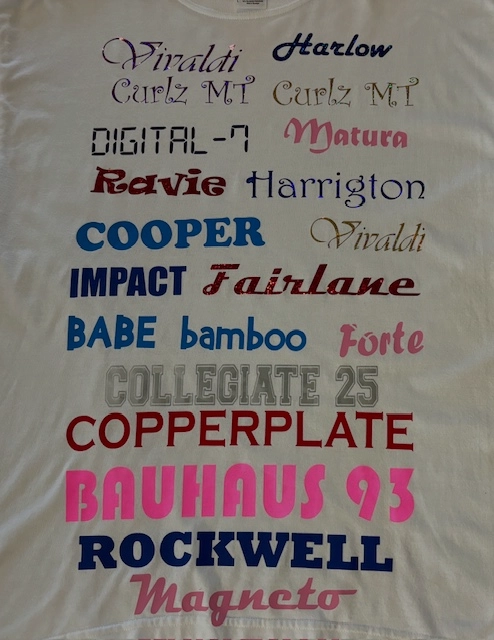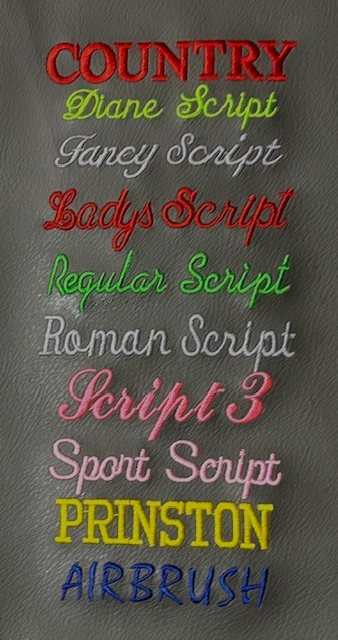Stitched Sports Teams Names and Numbers - Expert and Sturdy
Stitched Sports Teams Names and Numbers - Expert and Sturdy
Blog Article
The Art of Personalized Embroidery: Unlocking the Secrets to Creating Unique and Remarkable Styles
The keys to developing personalized needlework designs that captivate the eye and leave a long-term impact lie in a fragile equilibrium of method, creative thinking, and focus to detail. As we dive into the globe of custom needlework, we discover the nuanced interplay in between thread option, sew intricacy, and layout customization that elevates a plain garment to a job of art.
Picking the Right Embroidery Threads
When choosing needlework threads, what crucial factors should you consider to ensure the very best outcomes for your personalized styles? The choice of embroidery string is important in figuring out the last result of your embroidered layout. Among the main factors to consider is the material of the thread. Various materials such as cotton, polyester, rayon, and silk supply varying levels of sheen, toughness, and texture. It is necessary to choose a string product that enhances the textile you are stitching on and aligns with the preferred look of the layout.
Furthermore, the weight or thickness of the thread plays a significant function in the look of the needlework. Thicker strings can include dimension and texture to your style, while finer strings are excellent for complex information and small text. In addition, thinking about the shade fastness and washability of the thread is important to ensure that your custom styles maintain their top quality and vibrancy over time. By very carefully evaluating these variables and choosing top notch threads that meet your certain needs, you can enhance the visual appeal and durability of your stitched creations.
Discovering Various Stitch Strategies
To look into the world of 'Exploring Different Stitch Strategies', one must realize the details and subtleties that each sewing method brings to the art of embroidery. Various stitch techniques not only add aesthetic interest however likewise add to the overall appearance and dimension of the design. One popular stitch strategy is the satin stitch, which entails closely jam-packed parallel stitches to develop a smooth and shiny surface area, perfect for filling out forms and creating strong describes.
On the various other hand, the backstitch is a flexible method typically utilized for laying out and adding fine details. It entails stitching in reverse to produce a solid line of embroidery. In addition, the French knot stitch includes a responsive aspect to layouts, best for developing distinctive accents like blossom centers or ornamental touches.
Discovering different stitch techniques enables embroiderers to have fun with light, shadow, and deepness within their styles, elevating the visual allure and imaginative quality of their needlework jobs. By understanding various stitching techniques, one can unlock unlimited opportunities for creating distinct and memorable customized needlework pieces.
Incorporating Personalized Design Elements
Having actually discovered the intricacies of different stitch strategies such as the satin stitch, backstitch, and French knot, the emphasis currently changes in the direction of including personalized layout elements in custom embroidery tasks. Individualized style aspects play a critical duty in making embroidery projects absolutely special and remarkable.
One more means to integrate personalized layout elements is by consisting of symbols or themes that hold visit this site right here special significance to the recipient or show their interests and personality. For example, including a favorite blossom, animal, or hobby-related sign can make the embroidery design much more meaningful and tailored. Additionally, selecting shades that resonate with the recipient or straighten with the intended style can further improve the customization of the needlework project.
Mastering the Art of Color Control

One trick facet of color control is understanding shade theory. This consists of understanding exactly how various shades interact with each other, the feelings they share, and how they can be incorporated to create aesthetically appealing styles. By applying shade theory principles, embroiderers can produce harmonious shade palettes that enhance the overall appearance of the style.
In addition, paying focus to comparison is critical in color control. Using contrasting colors can help particular aspects of the layout pop, enhance clarity, and develop an aesthetically vibrant needlework item. By grasping the art of shade coordination, embroiderers can raise their layouts and produce memorable pieces that reverberate with clients and viewers alike.
Enhancing Texture With Advanced Embroidery Stitches

French knots, for example, are best for including small, increased dots to your informative post design, mimicking the look of beads or producing a distinctive surface. Bullion knots, on the various other hand, can be used to create twisted, ropelike aspects that include a lavish feeling to the needlework. Seed sewing includes little, scattered stitches that can fill up in locations with a polychromatic appearance, while turkey job develops fluffy, dimensional accents reminiscent of pet hair or foliage. Exploring with these innovative needlework stitches allows you to press the borders of traditional embroidery and create truly distinct and visually enticing appearances in your designs.
Final Thought
To conclude, the art of custom-made embroidery involves a combination of selecting the appropriate strings, exploring various stitch strategies, incorporating individualized design elements, grasping shade coordination, and boosting appearance with advanced stitches. By recognizing and carrying out these crucial elements, embroiderers can create one-of-a-kind and remarkable layouts that showcase their creativity and ability. Embroidery enthusiasts can unlock the secrets to developing lovely and custom pieces that stand apart and leave a lasting impression.
Report this page